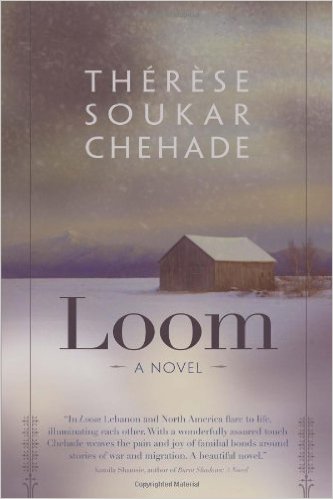Loom: A Novel
By Thérèse Soukar Chehade
Syracuse University Press, 2010
Thérèse Soukar Chehade’s most recent novel, “Loom,” delves into the minds and memories of the Lebanese-American Zaydan family as they brave a blizzard in the New England region. With each new chapter, the point of view switches to showcase the interiority of one of seven main characters: Emilie, the matriarch; Eva, Emilie’s niece; Josephine, Emilie’s daughter; George, Emilie’s son; Salma, George’s wife; Marie, Emilie’s granddaughter; and David, the neighbor whom Marie and Josephine have christened “Loom.” All of the characters are stranded: Eva is stuck in New York waiting for a flight that will take her to her family, David is occupying the home next door, and the rest of the characters are helpless in the family home. Most of the action takes place within the memories of the characters, as they all struggle to make sense of the emotions that have surfaced as a direct result of Eva’s visit or, as is most true in the case of David, the snowstorm itself. Emilie, who had already been sneaking David food for weeks when the storm hit, takes additional pity on him and goes out into the blizzard to deliver an elaborate meal. When she is caught in the snow, both households must temporarily join and, perhaps permanently, break their silence.
A major theme in this novel is the weight of regret, an emotion that all of the characters are consumed by. At many points in the novel, the characters are so fatigued or overcome by their feelings of regret that they appear to be living in their own personal hells. Even the crisp, blinding albedo of the snow mocks the way these memories create shadows in their lives. As the snow falls, the novel’s pace slows considerably to give room to the characters’ musings. This slowness is compensated for by Chehade’s outstanding skill in developing their memories, painting each with depth and sadness without making them tragic or depressing. The texture of her words makes the characters linger and their relationships seem richer, causing their experiences to take on a multi-dimensional quality – a feat difficult to achieve in a novel of relatively short length. I would venture that the least interesting character is the teen, Marie, because her naïveté stands out in this cast of middle-aged and elderly protagonists. However, that is part of the truth of the novel: that a lack of maturity can be detrimental to one’s own introspection.
Given the complexly rendered depiction of life in Lebanon, it was disappointing that Eva remained on the periphery of the novel. She constitutes an absent presence in the lives of Josephine, George and Emilie, as she is not physically present but occupies a significant place in their memories. As a result, the conclusion feels a bit unsatisfying. One could argue that such untidiness bears out the major themes of regret and longing. Chehade’s “Loom” joins a rich discussion within Arab- American literature surrounding the nuclear family (Yusuf El Guindi’s “Ten Acrobats in an Amazing Leap of Faith,” Alia Yunis’ “The Night Counter,” Mohja Kahf’s “The Girl in the Tangerine Scarf”), and the Lebanese Civil War (Rabih Alameddine’s “KOOLAIDS: The Art of War,” Patricia Serrafian Ward’s “The Bullet Collection”). Chehade takes part in this discussion and her voice is not muffled in the presence of her stellar peers; “Loom” stands on its own as a hauntingly beautiful read.
This article appeared in Al Jadid Magazine, Vol. 16, No. 63, 2010.
Copyright © 2010 AL JADID MAGAZINE

